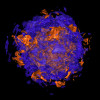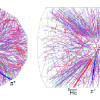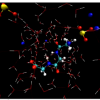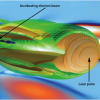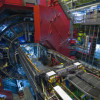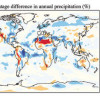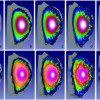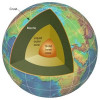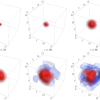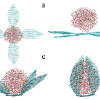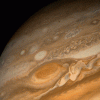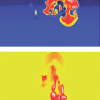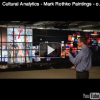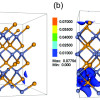Science News
Berkeley and Princeton Scientists Watch Stars Explode in 3D
Researchers from Princeton University and the Lawrence Berkeley National Laboratory have found a new way to make computer simulations of supernovae exploding in three dimensions. The new simulations are based on the idea that the collapsing star itself is not sphere-like, but distinctly asymmetrical and affected by a host of instabilities in the volatile mix surrounding its core. Read More »
NERSC Helps Shed Light on the Nature of Antimatter
Using the National Energy Research Scientific Computing Center's (NERSC) Parallel Distributed Systems Facility (PDSF) and the Brookhaven National Laboratory’s Relativistic Heavy Ion Collider (RHIC), physicists have detected and confirmed the first-ever antimatter hypernucleus, called "antihypertriton." Translated, the newly detected "antihypertriton" means a nucleus of antihydrogen containing one antiproton and one antineutron—plus one heavy relative of the antineutron, an antilambda hyperon. Most of the objects in the cosmos today consists of matter, comprised of "normal" particles like positively charged protons and negatively charged electrons. Read More »
Dancing in the Dark
Berkeley Lab scientists have applied x-ray absorption spectroscopy to study a model protein, triglycine – a short chain of three molecules of the simplest amino acid, glycine. By simulating this molecule’s x-ray absorption spectrum the team has show how its chain kinks and straightens in response to ions in solution. Read More »
Taking the 'Large' out of Large Hadron Collider
Particle accelerators like the Large Hadron Collider (LHC) at CERN are the big rock stars of high-energy physics—really big. The LHC cost nearly USD$10 billion to build and its largest particle racetrack (27 km in circumference) stretches across a national border. However, a recent breakthrough in computer modeling may help hasten the day when accelerators thousands of times more powerful can be built in a fraction of the space—and for significantly less money. Read More »
California Is the Primary U.S. Stop for LHC's ALICE Data
For approximately one month a year, the nuclei of lead atoms traveling near the speed of light will collide in the Large Hadron Collider's (LHC) ALICE experiment, generating a fireball about 100,000 times hotter than the core of our Sun. At these temperatures protons and neutrons dissolve into a "particle soup" of quarks and gluons, known as the quark-gluon plasma—a state of matter that first occurred in nature at the birth of our Universe almost 14 billion years ago, a few millionths of a second after the Big Bang. By watching this "soup" cool, physicists hope to better understand the nature of matter, which makes up everything from galaxies to humans. Read More »
Simulations Show That "Sweaty" Flowers Cool the World
The world is a cooler, wetter place because of transpiring flowers, say University of Chicago researchers who ran more than a million lines of code on the National Energy Research Scientific Computing Center's (NERSC's) IBM Power5 "Bassi" system last year. They found that this effect is especially pronounced in the Amazon basin, where 80 percent of ever-wet rainforest area would not exist without flowering plants. These findings were published online on June 16, 2010 in Proceedings of the Royal Society B. Read More »
Computing Enables New Insights into Generating Power Like the Sun
If humans could harness nuclear fusion, the process that powers stars like our sun, the world could have an inexhaustible energy source. But researchers still do not understand the behavior of plasmas well enough to effectively confine them to generate a sustainable flow of energy. NERSC simulations show that that instabilities at the plasma edge can can cause multiple pulses of instability, which damage plasma containment chambers. Read More »
Simulations Reveal Earth's Silica Is Predominantly Superficial
Silica is one of the most common minerals on Earth. Not only does it make up two-thirds of our planet's crust, it is also used to create a variety of materials from glass to ceramics, computer chips and fiber optic cables. Yet new quantum mechanics results generated by a team of physicists computing at the National Energy Research Scientific Computing Center (NERSC) show that this mineral only populates our planet superficially—in other words, silica is relatively uncommon deep within the Earth. Read More »
Bringing Clouds into Focus
David Randall, principal investigator for the "Global Cloud Modeling" project that computes at NERSC, is working to clear up uncertainty in global climate models caused by differing methods of accounting for the effects of clouds. He is developing and testing a new kind of global climate model, called a global cloud resolving model (GCRM)—a model that's designed to take advantage of the extreme-scale computers expected in the near future. Read More »
Brace for Impact
While the fireworks at CERN's Large Hadron Collider (LHC) transfix the world, theorists are quietly doing some computational heavy lifting to help understand what these particle smash-ups might reveal about the fundamental mystery of existence: Why is there anything at all? The Standard Model of particle physics can't explain why there exists more matter than antimatter in the universe. At the LHC and other colliders, scientists sift the debris of high-energy particle collisions searching for clues to physics that lie beyond our current understanding. Read More »
NERSC Users Find That Nanodroplets of Water Can Manipulate Graphene
Chemists from the University of Illinois at Chicago using the National Energy Research Scientific Computing Center's (NERSC) Cray XT4 supercomputer, called Franklin have found that nanodroplets of water can be used to shape graphene into complex capsules, sandwiches, knots, and rings to serve as the building blocks of nanodevices with unique mechanical, electrical, and optical properties. Read More »
NERSC Helps Locate Jupiter's Missing Neon
It's raining helium on Jupiter—and as these droplets fall towards the planet's deeper interior, they are bringing neon down with them. This new result, published in the March 26 issue of Physical Review Letters, solves a 15-year-old mystery that was initiated on December 7, 1995, when NASA's Galileo probe plunged into Jupiter's atmosphere and found only one-ninth the amount of neon that should have been there based on measurements of the Sun's composition. The authors, Burkhard Militzer and Hugh Wilson of the University of California, Berkeley, were able to answer this decade-old question with some supercomputing help from the Department of Energy's National Energy Research Scientific Computing Center (NERSC). Read More »
Baby Brutes
Astronomers have in recent years been surprised to find hulking brutes among the baby galaxies of the early Universe. Studded with bright, giant clumps of rapidly forming stars, these big galaxies hail from a time when the cosmos was less than 4 billion years old, yet each contains about the mass of a modern Milky Way, which took 10 billion years to form. Once considered oddities, these galaxies are now thought to be the engines that drove the Universe's most active period of star formation. It remains a mystery, however, how such massive galaxies came to be so quickly and what has happened to them in our modern Universe. Read More »
A Computational Science Approach for Analyzing Culture
Just as photography revolutionized the study of art by allowing millions of people all over the world to scrutinize sculptures and paintings outside of museums, researchers from the Software Studies Initiative at the University of California at San Diego (UCSD) believe that a new paradigm called cultural analytics will drastically change the study of culture by allowing people to quantify evolving trends across time and countries. Read More »
Mismatched alloys are a good match for thermoelectrics
Employing some of the world’s most powerful supercomputers, scientists at Lawrence Berkeley National Laboratory have shown that mismatched alloys are a good match for the future development of high performance thermoelectric devices. Read More »






